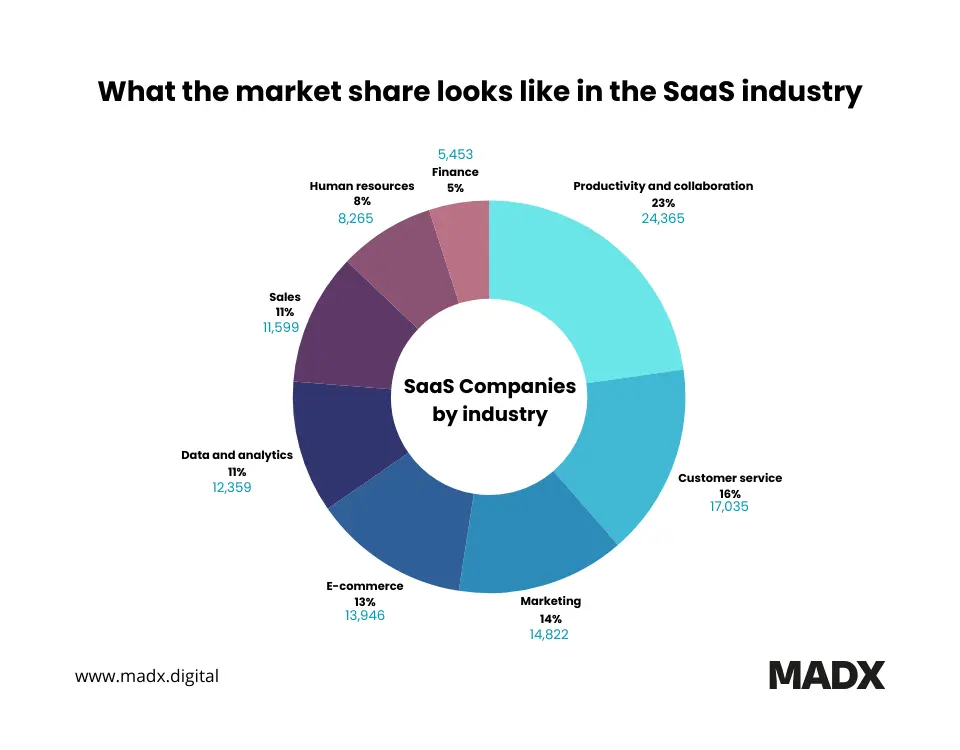- Product development
- 9 Sep 2024
Benefits of SaaS development for small and medium companies
The Software as a Service industry is rapidly growing.



Table of contents
- What is a SaaS platform
- How does the software as a service industry look like
- How does a SaaS model work
- What advantages come with using SaaS (software-as-a-service) solutions?
- Benefits of SaaS development vs. on-premise solutions
- Comparing Infrastructure as a Service (IaaS) and Platform as a Service (PaaS) to Software as a Service Platform (SaaS)
- The risks and disadvantages of SaaS app development for better business performance
- SaaS for small business vs. SaaS for enterprise
- Conclusion
Contributors

What is a SaaS platform
A SaaS platform (Software as a Service) delivers apps and tools over the Internet. Instead of installing and maintaining software, you can access it online, eliminating the need to manage complex software and hardware.
The Software as a Service industry is rapidly growing, with new apps by the day—and for sure one of the most profitable ones. There are multiple benefits of developing your own SaaS, so we’ll go through them one by one.
How does the software as a service industry look like
As we mentioned above, the SaaS industry is skyrocketing in terms of market size, standing at USD 273.55 billion in 2023 and being projected to grow from USD 317.55 billion by the end of 2024 to USD 1,228.87 billion by 2032, according to a recent Fortune Business Insights report.
This is because many firms are more prone to shifting to cloud-based solutions for future market growth.
Whether it’s communication or project management software, organizations are adopting more and more SaaS tools to manage tasks; plus, B2B SaaS apps are great for a linked digital ecosystem due to how well they integrate with other business systems.
 Source: MADX
Source: MADX
How does a SaaS model work
The SaaS business model works on a subscription-based structure, where users pay monthly or annually subscriptions to access and use the software without the need for purchasing hardware.
While traditional software involves one-time purchases, SaaS spreads the cost over time, which is definitively an advantage for customers looking for lower upfront investments while also gaining the flexibility to scale based on needs.
The 3 pillars SaaS models function on are:
- Recurring Payments: This offers you a predictable income but also introduces complexities in revenue recognition because payments are tied to ongoing service delivery.
- Customer Retention: Retention is a must because it directly impacts your company’s bottom line. High customer churn (i.e., customers leaving the service) can severely affect recurring revenue streams. So we recommend focusing on building relationships, offering great customer support, and upselling to offer the best customer experience and keep subscribers engaged over time.
- Consistent Updates: Another important aspect is the development of continuous improvements, security patches, and new features without requiring your users to manually install anything. By doing this, you’re not only keeping your SaaS solution up to date but also enhancing customer satisfaction by constantly adding value to the service you’re providing.
If you’re curious about the different types of SaaS applications that fit within this model, you might find it helpful to explore our detailed guide on the types of SaaS applications.
What advantages come with using SaaS (software-as-a-service) solutions?
In order to develop a top-notch SaaS solution for your customer base, you need to put yourself in the skin of your user and keep in mind the advantages they should benefit from by choosing to purchase your SaaS app.
These are the advantages that can influence your audience to transition to users of your SaaS platform:
- Cost savings right from the start;
- Scalability and growth;
- Works from anywhere;
- Automatic updates;
- High Security;
- Fast and easy setup;
- Data and optimization;
- Better customer support and experience.
Benefits of SaaS development vs. on-premise solutions
We put together the benefits of SaaS development vs. traditional software development, so you can clearly see why choosing SaaS is the most fast and profitable for a long-term solution you can provide to your users.

To sum this up, SaaS development can offer recurring revenue for your business, as well as a higher chance of scalability and faster updates.
Traditional software, on the other hand, offers a higher revenue upfront but involves higher long-term maintenance and fewer opportunities for customer interaction and service enhancement.
Comparing Infrastructure as a Service (IaaS) and Platform as a Service (PaaS) to Software as a Service Platform (SaaS)
IaaS, PaaS, and SaaS are sometimes referred to as cloud service models or cloud computing service models.
In short, each of them has their own particularities:
- IaaS (Infrastructure as a Service) gives you virtual hardware like servers and storage.
- PaaS (Platform as a Service) provides tools for building and managing software applications.
- SaaS (Software as a Service), as you already know, delivers ready-to-use software applications over the internet.
 Source: ClickIT
Source: ClickIT
The risks and disadvantages of SaaS app development for better business performance
If you decide to go further and start developing a SaaS platform, you need to keep in mind that you can find yourself challenged by some unexpected aspects. First, profitability pressure is intensifying due to rising costs and a large pool of competitors, making it harder for SaaS companies to maintain healthy profit margins.
Second, AI integration is both an opportunity and a headache. While AI can offer a competitive edge, it’s tough to implement effectively without the right talent.
Third, the shift in B2B buying behavior means customers now expect self-service options and personalized experiences, which requires quick adaptation.
Fourth, regulatory changes are becoming more strict, especially around data privacy, meaning SaaS providers must stay compliant or face hefty fines.
Lastly, global scaling brings its own set of complexities, such as navigating different tax laws and understanding regional markets, which can be a logistical nightmare.
SaaS for small business vs. SaaS for enterprise
The SaaS software development process varies significantly between small businesses and enterprises. Their unique needs shape the development approach. Small businesses seek agile and cost-effective solutions, while enterprises require scalable and customizable platforms. SaaS development companies must understand these differences. They need to tailor their frameworks and strategies to deliver the best solutions for each market segment.
Why choose SaaS as a business model
When you opt for SaaS as a business model, you gain many advantages. These include being able to generate recurring revenue, easily scale your operations, and swiftly deploy your services. Businesses are drawn to SaaS solutions in the software as a service industry because they offer lower upfront costs, continuous updates, and improved accessibility. It’s a win-win situation for companies looking for these benefits. With this model, companies can efficiently deliver software-as-a-service solutions that are flexible and customer focused.
SaaS application development framework
Small and large organizations have distinct demands than one another, and the SaaS development framework is designed to meet those differences. Small businesses put emphasis on agile, cost-effective SaaS app development that provides quick-to-market solutions with essential features. This approach highlights the advantages of SaaS, such as reduced upfront costs and user-friendly interfaces. In contrast, enterprise-level SaaS software development firms prioritize complicated, customisable, and scalable SaaS systems with strong security and integration capabilities.
It’s important to fully understand the fundamentals of a SaaS model. Small businesses can take advantage of SaaS software to enhance their flexibility and operational efficiency. While enterprises need more advanced features like multi-tenancy and microservices to stay in line with industry standards. Both of these benefit from a customized SaaS development framework.
Whether you’re a small business or a multinational company, your choice of SaaS application development framework is crucial. It impacts your ability to adapt quickly to changing market conditions. It also affects how you scale operations and manage costs efficiently.
Best SaaS products for small businesses
1. Project Management
Todoist shows clients their daily duties, from business to shopping lists, by giving organization and growth first priority in order to free their thoughts. This platform shows using daily and weekly goals that small acts have great impact.
2. Content Creation
Promo, the top marketing video provider worldwide, offers top technology, adjustable templates, and an extensive clip library to enable you to create the best ads, explainers, social media videos, and more. Their creative center provides a number of excellent video marketing ideas.
3. Marketing
Constant Contact uses email marketing tools to enable companies to create and oversee online campaigns. This SaaS solution lets you create websites, email campaigns, social network profiles, and e-commerce shopfronts.
4. Business IQ
Sales Intel helps its users target the best prospects and increase income generation. Basically, this SaaS offers premium sales and marketing contact information. Sales Intel’s industry-leading direct calls and personally verified contacts help business insight.
Enterprise software as a service solution
It’s incredible how quickly hosted services are growing, and it’s clear that enterprise-level SaaS is now a widely embraced and popular choice. Nowadays, many global enterprises opt to handle their own mission-critical processes of performance.
If you’re thinking about creating and promoting premium SaaS solutions, be prepared for a significant initial investment. These solutions can be tailored to meet the specific needs of any company. Before moving forward, take time to explore the trends. Weigh the pros and cons, and carefully assess your available resources for the project.
Enterprise SaaS pricing
The cost of developing an enterprise SaaS platform can vary greatly, ranging from 45,000€ to 150,000€ or more. Several factors in SaaS development have either a bigger or smaller impact on pricing. These elements will ultimately determine the overall cost of your application.
Usually running you back anywhere from 45,000€ to 100,000€ is a simple SaaS MVP, minimum viable product. If you wish a more creative and unconventional use, though, you may be looking at a bill upwards of 250,000€.
Read more about SaaS cost factors here.
Conclusion
Building a SaaS application offers many great benefits. You can generate steady, recurring revenue. You also maintain strong control over your brand and enhance customer satisfaction.
Plus, you’re tapping into the cloud’s scalability and efficiency right from the get-go.
If you’re considering bringing a SaaS product to market for your company, let’s have a chat and see how we can support you in starting your SaaS development journey.
HR Workflow Automation: Cut Onboarding Time by 60% While Ensuring Compliance
How to Reduce Financial Close Time by 3 Days with ERP Workflow Automation
Outsourcing vs. In-house Development: Why Romania is the Best Middle Ground